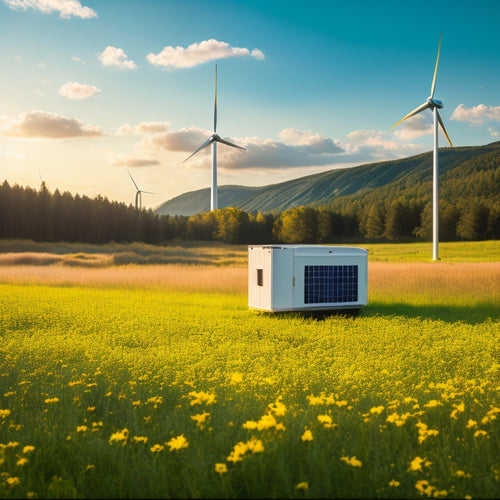
7 Tips for Portable Energy Independence
Share
You're initiating a quest to utilize the freedom and flexibility of portable energy independence, where you can generate and manage your own power on the go, untethered from the grid. To accomplish this, you'll need to evaluate your energy needs, choosing the right solar panels and compatible battery for your setup. Designing a portable system that meets your power requirements is vital, and maximizing energy efficiency will help you reduce your overall energy usage. Additionally, overcoming common challenges and maintaining your system will guarantee continuous energy independence. By considering these fundamental factors, you'll be well on your way to achieving true energy autonomy, and there's more to investigate on this path to self-sufficiency.
Overview
- Assess energy needs by tracking appliance wattages and usage duration to determine accurate daily energy calculations for system sizing.
- Choose solar panels with high efficiency rates, compact designs, and high power-to-weight ratios for reliable and portable energy generation.
- Select compatible batteries based on performance, usage scenarios, and capacity ratings, considering lead-acid, lithium-ion, and deep cycle options.
- Design a portable system with a suitable power source, configuration, and management strategy, incorporating renewable energy sources and efficient storage solutions.
- Optimize energy usage by implementing insulation improvements, upgrading to energy-efficient appliances, and adjusting thermostat settings for energy conservation.
Assessing Your Energy Needs
When it comes to achieving portable energy independence, understanding your energy needs is the essential first step towards designing a system that truly meets your requirements.
You'll need to assess your energy consumption patterns to determine how much power you require. Take a close look at your lifestyle and identify areas where you can make changes to reduce your energy usage.
Consider your daily habits, such as charging your devices, using lights, and running appliances. To get an accurate calculation of your daily energy usage, track appliance wattages and usage duration and conduct an energy audit to reveal inefficiencies and improvement opportunities.
Make a list of your essential items and calculate their energy demands. By doing so, you'll be able to determine the size of the system you need, ensuring you have a reliable and efficient source of power on the go.
Choosing the Right Panels
When choosing the right panels for your portable energy independence, you'll want to reflect on three key factors: panel efficiency, size and space constraints, and budget and quality tradeoffs.
Higher-efficiency panels may be more expensive, but they can provide more power in a smaller footprint.
Since a dependable power source is vital for alleviating power anxiety and ensuring devices remain charged, it's important to select panels that cater to your diverse camping power requirements.
You'll need to weigh these factors to select the best panels for your specific energy needs and setup.
Panel Efficiency Matters
How much power can you realistically expect from your solar panel system? The answer largely depends on the efficiency of your panels.
With advancements in solar technology, modern panels boast higher efficiency rates than their predecessors. For instance, bifacial solar panels can absorb light from both sides, increasing energy yield by up to 25%.
When shopping for panels, look for high-efficiency models that can convert more sunlight into electricity. This is essential for performance optimization, as it directly impacts the overall power output of your system.
A highly efficient panel can generate more power per hour of sunlight, giving you more energy independence.
Size and Space Constraints
With space at a premium in your portable energy setup, selecting the right solar panels is vital to maximizing your power output while minimizing footprint.
You'll want to contemplate compact designs that don't sacrifice efficiency for portability. Look for panels with high power-to-weight ratios, as this will allow you to generate more energy without adding bulk to your setup.
When choosing a DIY solar kit, consider residential solar panel bundles that combine panels, inverters, and mounting hardware for convenience.
Weight considerations are significant, as you'll need to transport your panels easily. Think about the dimensions of your storage space and choose panels that fit snugly, allowing for efficient use of space.
Budget and Quality Tradeoff
Set a realistic budget for your portable energy setup, and then balance it against the quality of solar panels you need. Conduct a cost analysis to determine how much you're willing to spend on your system.
Consider the quality indicators that matter most to you, such as efficiency, durability, and warranty. High-quality panels may be more expensive upfront, but they'll provide more power and last longer, saving you money in the long run.
On the other hand, cheaper panels may not meet your energy needs or withstand harsh outdoor conditions. Weigh the pros and cons of each option to find the right balance for your budget and energy goals.
Selecting a Compatible Battery
You need a battery that can handle the unique demands of your portable energy system. With so many options available, it's crucial to evaluate the key factors that impact performance.
| Battery Types | Key Features | Usage Scenarios |
|---|---|---|
| Lead-Acid | Affordable, low maintenance | Camping, emergency power |
| Lithium-Ion | High capacity, lightweight | Off-grid excursions, RVs |
| Deep Cycle | Long lifespan, solar compatible | Remote homes, cabins |
When selecting a battery, assess capacity ratings, solar compatibility, charging cycles, weight considerations, discharge rates, and lifespan factors. These factors will help you choose the right battery for your portable energy system, ensuring you stay powered up on the go.
Designing a Portable System
When designing a portable system, you'll need to contemplate system configuration options that suit your energy needs, such as series, parallel, or series-parallel connections.
You'll also need to select a power source, like solar, wind, or fuel cells, that aligns with your specific requirements and environmental conditions.
System Configuration Options
Three primary system configuration options emerge when designing a portable energy independence system: series, parallel, and series-parallel. Each configuration has its advantages and disadvantages, and choosing the right one depends on your specific needs and goals.
| Configuration | Description |
|---|---|
| Series | Higher voltage, lower current; suitable for systems with few, high-voltage components |
| Parallel | Lower voltage, higher current; ideal for systems with many, low-voltage components |
| Series-Parallel | Combines benefits of both; offers flexibility and scalability |
When selecting a configuration, consider your solar inverter options and battery management requirements. A well-designed system guarantees efficient energy harvesting, storage, and distribution, giving you the freedom to live life on your own terms.
Power Source Selection Guide
Designing a portable energy independence system starts with selecting the right power source, as it sets the foundation for your entire setup.
You'll want to evaluate renewable energy options that align with your energy conservation goals. Alternative technologies like solar, wind, or hydro power can provide innovative solutions for your portable system.
If you need a backup, look into eco-friendly portable generators that minimize your carbon footprint.
To optimize your power management, contemplate smart devices that enable energy forecasting and efficient distribution.
By choosing the right power source, you'll be well on your way to achieving sustainable practices and true energy independence.
Remember to assess your specific needs and balance them with your energy goals to make an informed decision.
Efficient Energy Storage
As you've chosen the right power source, now it's time to contemplate efficient energy storage solutions that will guarantee a reliable and consistent flow of power in your portable system.
When selecting a battery, consider energy density, which measures the amount of energy stored per unit of weight and volume. You'll want a battery with high energy density to minimize size and weight.
Common battery types for portable systems include lithium-ion, lead-acid, and nickel-cadmium. Lithium-ion batteries offer high energy density and long lifetimes, making them a popular choice.
Consider your specific power requirements and environmental factors when choosing the best battery for your needs.
Maximizing Energy Efficiency
By optimizing your energy usage patterns, you can greatly reduce your reliance on external power sources, thereby achieving greater portable energy independence.
Conducting energy audits helps identify areas of inefficiency, allowing you to make targeted improvements. Implementing insulation improvements and appliance upgrades can considerably reduce energy consumption.
Making lifestyle changes, such as adjusting your thermostat or using energy-efficient lighting, also contributes to energy conservation.
Additionally, consider incorporating renewable sources, like solar or wind power, into your energy mix.
Utilize smart technology to monitor and control your energy usage in real-time, making adjustments as needed.
Overcoming Common Challenges
In tandem with optimizing energy usage, overcoming common challenges is essential to achieving portable energy independence.
You'll face unique obstacles depending on your solar setup and environment considerations. For instance, you may need to adjust your energy optimization strategy based on weather impact or usage habits.
Portability factors, like inverter choices and cable management, can also pose challenges. To overcome these, develop charging strategies that work for you and gather user feedback to refine your approach.
Maintaining Your System
Your solar panels and battery bank are the backbone of your portable energy independence, and regular maintenance is vital to assure they continue to perform at their best.
Set a schedule for monitoring performance, cleaning techniques, and safety precautions to guarantee peak output. Troubleshooting tips will help you identify and fix issues before they become major problems.
Consider seasonal adjustments to your system, such as tilting your panels for winter or summer. Keep an eye out for component replacements, and plan for system upgrades to stay ahead of the game.
Frequently Asked Questions
Can I Use a Portable Energy System for My RV or Boat?
You can definitely use a portable energy system for your RV or boat, leveraging solar panels to capture sunlight and store excess energy in battery storage, giving you the freedom to roam wherever, whenever.
How Do I Protect My System From Theft or Vandalism?
As you venture into the wild, your prized system is like a precious gem, vulnerable to thieves and vandals. You'll want to shield it with security measures like GPS tracking, tamper-evident devices, and sturdy enclosures to prevent theft and vandalism.
Can I Use a Portable Energy System for Backup Power at Home?
You can use a portable energy system as a backup power source at home, leveraging solar generators with sufficient battery capacity to cover your essential appliances during outages, ensuring your independence and comfort.
Are Portable Energy Systems Safe for Use in Wet or Humid Environments?
When venturing into wet or humid environments, you'll want to shield your system from soggy sabotage. Look for waterproof features and assess humidity effects on your portable energy setup to guarantee reliable, rain-or-shine performance that keeps you powered up and free.
Can I Expand My Portable Energy System in the Future?
You can easily expand your portable energy system in the future by choosing components with system compatibility in mind, ensuring seamless future upgrades and allowing you to scale up or modify your setup as your needs evolve.
Ready to Buy
You've made it! With these 7 tips, you're well on your way to achieving portable energy independence. As you start on this expedition, remember that the average American uses 900 kilowatt-hours of electricity per month. Imagine having the freedom to power your escapades with clean energy, wherever you roam. By following these guidelines, you'll be utilizing the sun's energy in no time, and kissing fossil fuels goodbye. Get ready to unplug and experience the thrill of true energy independence!
Related Posts
-

Sustainable and Eco-Friendly Generators for a Reduced Carbon Footprint
Sustainable and eco-friendly generators are perfect for cutting your carbon footprint and increasing energy efficienc...
-

Replacing Old Appliances With Sustainable Alternatives
Replacing old appliances with sustainable alternatives can change your home into an energy-efficient space. Not only ...
-

Designing a Green Roof for Maximum Energy Efficiency
Designing a green roof for maximum energy efficiency involves several key strategies. Start by selecting native, drou...


